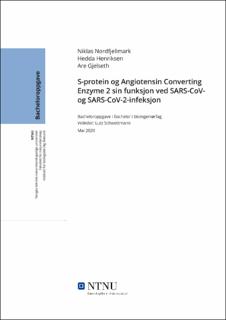| dc.contributor.advisor | Schwettmann, Lutz | |
| dc.contributor.author | Nordfjellmark, Niklas | |
| dc.contributor.author | Henriksen, Hedda | |
| dc.contributor.author | Gjelseth, Are | |
| dc.date.accessioned | 2020-07-07T16:09:17Z | |
| dc.date.available | 2020-07-07T16:09:17Z | |
| dc.date.issued | 2020 | |
| dc.identifier.uri | https://hdl.handle.net/11250/2661283 | |
| dc.description.abstract | SARS-CoV-2 er et nylig oppdaget virus som deler flere likheter med SARS-CoV som forårsaket SARS-epidemien i 2003. I denne bacheloroppgaven ble det tatt sikte på å identifisere mulige faktorer som kan forklare hvorfor dagens situasjon er annerledes enn SARS-utbruddet i 2003. Fokuset ble rettet mot å finne vitenskapelig publisert informasjon om ulikheter i de to virusenes “spike”-proteiner på aminosyrenivå og en nylig utviklet modell for å predikere coronavirus sin motstandsdyktighet.
Teoridelen beskriver først virus og coronavirus på generell basis etterfulgt av en detaljert forklaring på SARS-CoV-2 sin struktur og en generell betraktning av hvordan SARS-CoV-2 fusjonerer med, og replikeres, i vertscellen. Videre belyses funksjonen til renin-angiotensin-systemet (RAS) i menneskekroppen og det blir gitt en detaljert forklaring av G-koblet reseptor (GPCR) som er en viktig reseptortype å forstå i sammenheng med RAS.
Det ble tatt stilling til funksjon og oppbygging av angiotensin converting enzyme 2 (ACE2), som er reseptoren både SARS-CoV og SARS-CoV-2 binder seg til før fusjon kan initieres.
For å finne relevant litteratur ble det brukt lærebøker, review-artikler og forskningsartikler fra søk via PubMed. Resultatet består av 11 artikler som er spesielt relevant for vår problemstilling.
Diskusjonsdelen er todelt og tar først og fremst sikte på å identifisere relevante ulikheter mellom SARS-CoV og SARS-CoV-2. Her ble det funnet at SARS-CoV-2 binder med høyere affinitet til ACE2 og benytter en ekstra protease i fusjonsprosessen som er uttrykt i svært mange av kroppens vev. I tillegg ble det satt fokus på et nytt klassifiseringssystem (PID) for coronavirus som er ment å kunne predikere virusets motstandsdyktighet mot ytre påvirkninger. Ifølge dette bør SARS-CoV-2 ha en relativt hard ytre skallstruktur, og resultater derfra tyder på at SARS-CoV-2 kan ha større evne til å motstå ytre påvirkninger sammenliknet med SARS-CoV. I praksis antyder resultater fra anvendelsen av metoden at SARS-CoV-2 vil kunne beholde sin ytre beskyttende struktur lengre i miljøer utenfor vertsorganismen og ekstracellulært i kroppsvæsker, som igjen vil si at man trenger færre infektive viruspartikler for å videreføre smitten effektivt.
Den andre delen av diskusjonen tar for seg det kliniske bildet ved COVID-19, først og fremst med hensyn til den patologiske effekten på lunger og hjerte. Dette blir sett i sammenheng med RAS på et overordnet nivå. Koekspresjon av vertscellereseptoren ACE2, med de nødvendige proteasene for fusjon, er også tatt med her. Dette ble gjort for å kartlegge hvilke vev SARS-CoV-2 kan angripe. Til sammenlikning med SARS-CoV ble det funnet at SARS-CoV-2 har større potensiale til å angripe flere vev; blant annet lunge, hjerte, lever og tarm. | |
| dc.description.abstract | SARS-CoV-2 is a newly discovered virus that bears many similarities to SARS-CoV, which caused the SARS epidemic in 2003. This bachelor´s thesis was aimed at identifying possible factors that may explain why the current situation is different from the one surrounding the SARS outbreak in 2003. The focus was aimed at determining differences in amino acid sequences in S protein and a recently developed model for predicting coronavirus resistance.
The theoretical background section initially describes viruses and coronaviruses on a general basis, followed by a detailed explanation of the structure of SARS-CoV-2 and a general consideration of how SARS-CoV-2 enters and replicates in the host cell. Furthermore, the renin-angiotensin system (RAS) of the human body is elucidated, and a detailed explanation is provided for GPCR, a receptor type that is important to understand in the context of RAS.
The function and structure of ACE2 was considered. This is the receptor with which both SARS-CoV and SARS-CoV-2 bind before entry by endocytosis and membrane fusion can be initiated.
In order to procure relevant literature textbooks, review articles and research articles from PubMed database searches were used. The result consists of 11 articles that were deemed particularly relevant to our thesis.
The discussion section is two-fold and aims primarily at identifying relevant differences between SARS-CoV and SARS-CoV-2. Here, it was found that SARS-CoV-2 binds with higher affinity to ACE2 and utilizes an additional protease prior to the fusion process. This protease is expressed in many body tissues. In addition, a new coronavirus classification system (PID) was introduced, which is intended to predict the virus's resistance to external influences. Accordingly, SARS-CoV-2 should have a relatively hard outer shell structure and results from the same research group suggest that SARS-CoV-2 may have greater ability to withstand external influences compared to SARS-CoV. In practice, the method suggests that SARS-CoV-2 is able to retain its outer protective structure shielding the viral RNA longer in environments outside the host organism and extracellularly in body fluids, which in turn means that fewer infectious particles are needed to infect effectively.
The second part of the discussion deals with the clinical features of COVID-19; primarily with regard to the lungs and heart. This is seen in the context of RAS at an overall level. An overview of tissues with coexpression of the host cell receptor ACE2 with the necessary proteases for fusion is also included here. This was to identify which tissues and cells are susceptible to being attacked by SARS-CoV-2. When compared to SARS-CoV, it was found that SARS-CoV-2 has the greater potential to infect multiple tissues and organs, including lungs, heart, liver and intestines. | |
| dc.publisher | NTNU | |
| dc.title | S-protein og Angiotensin Converting Enzyme 2 sin funksjon ved SARS-CoV- og SARS-CoV-2-infeksjon | |
| dc.type | Bachelor thesis | |
